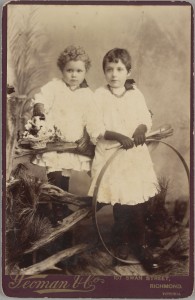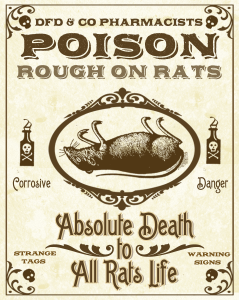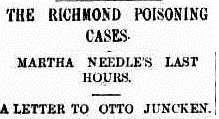Martha Needle, MS 8296
In 1894, Martha Needle was sentenced to death for the murder of her prospective brother in law, Louis Juncken, and executed in the Old Melbourne Gaol. She was also said to have poisoned her husband Henry, their three daughters Mabel, Elsie and May, as well as attempting to murder Herman Juncken.
Martha was born Martha Charles in Port Adelaide in 1864. After working as a domestic, she married carpenter Henry Needle when she was seventeen (South Australian Register). The couple then moved to Victoria with their three daughters and lived in Richmond. In 1885 eldest daughter Mabel died, then in 1889, her husband Henry died. On Henry’s death-bed Martha received £60 life insurance. When Elsie died soon after, Martha received Elsie’s share of the insurance, another £60. In 1891, the third daughter, May, died and Martha received the balance of the insurance money, another £80.
May and Mabel Needle, MS 8296
In 1892 Martha became engaged to carpenter Otto Juncken and worked as the housekeeper to Otto and his two brothers. In 1894 brother Louis became gravely ill and died. He was said to have suffered from ‘severe abdominal pain and violent retching, and though the homely remedies administered by Mrs. Needle gave him relief, he did not recover his usual health’ (The Argus). His body was returned to South Australia and Otto journeyed to Adelaide to attend the funeral, remaining there with his family for some time. Martha’s fury at his absence was evident in a letter she sent to him that was later printed in The Argus.
Otto returned to Melbourne and to Martha and was soon followed by his brother Herman who came to settle Louis’ affairs. Herman let it be known that his family was strongly opposed to the marriage. Within a matter of days he became violently ill after eating a meal prepared by Martha. Fortunately his doctor recognised the symptoms of irritant poisoning and arranged for an analysis to be made. The results showed considerable quantities of arsenic coloured by charcoal, used in the popular rat poison of the time called ‘Rough on Rats’.
The police arrested Martha and charged her with the attempted murder of Herman Juncken. Apparently she was ‘caught by the police in the very act of offering a cup of tea containing 10 grains of arsenic to Herman’ (The Advertiser) .
During the investigation police acknowledged the similarities between the deaths of Louis Juncken, Henry Needle and the three children and sought permission to exhume the bodies. Subsequently, the bodies of Louis, Henry, Elsie and May were found to contain various quantities of arsenic.
Otto regularly visited Martha in gaol and in a letter to his mother said he hoped Martha ‘will be proved to be insane, and therefore not responsible for her misdeeds,’ (The Advertiser), however Martha was sentenced to death.
The Argus, 24 October 1894
On 22 October, Martha, still protesting her innocence, was hanged at the Melbourne Gaol. She left her estate, valued at 25 pounds, to Otto and in her final letter to him wrote:
`When you receive this you can think of me as being in a happy home with my loved ones, waiting and watching for you. I know, dear Otto, that you will get ready for that happy meeting with us all’. (The Argus)
Otto went on to marry, have six children and live a long and incredibly successful life. In 1918 he formed a partnership with Lauritz Hansen and together they built some of Melbourne’s most iconic buildings, including the Collingwood Football Club Grandstand, the National Bank in Collins Street, the Port Authority Building and the Sun Theatre. It was Otto who designed the innovative suspended scaffold that was used to replaster the domed ceiling in the State Library.
We have some digitised material in our Manuscripts collection relating to Martha Needle, including a letter from Martha on prison note-paper to friend Mrs Owen. The other letters are from Otto Juncken to Mrs Owen. Also included are portraits of Martha and two of her three children and her annotated miniature bible of the New Testament.
Bibliography
Cannon, M 1994, The woman as murderer: five who paid with their lives, Today’s Australia Pub. Co., Mornington, Vic.
Compiled by Sarah Ryan, Librarian, Victorian and Australian Published Collections
Contributions by Ann Copeland, Librarian, Family History






Thanks for researching and sharing this! It was very interesting.
Hi Jennifer. Thanks for your comment. Glad you found the post interesting. It’s certainly an amazing story.
WOW …VERY INTRUSTING STORY I LOVE IT .ALL THESE DRAMA IN THAT’S DAYS.
GOOD JOB SARAH .WELL DONE
CHEERS
HAJIR J
Thanks for your comment Hajir J. It is a very interesting story. I’m glad you enjoyed the blog post.
Interesting story!
Hi Heidi
The story of Martha Needle is certainly a fascinating one. Thanks for reading our blog.